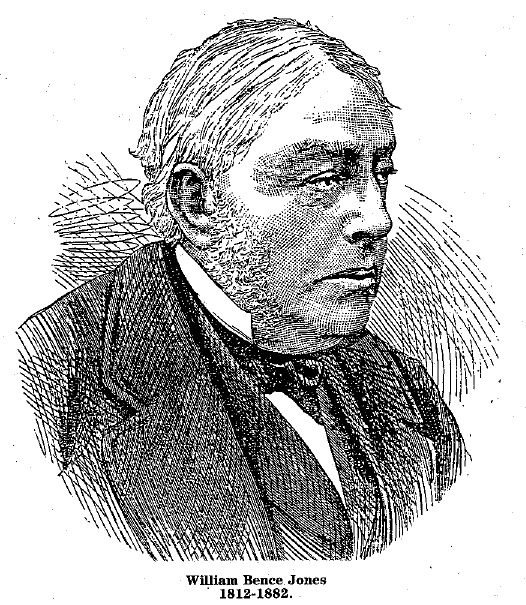
The Famous 1881 Debate - Key Issues
While in popular folklore, the grate debate between Father John O'Leary and William Bence Jones is often mentioned, and particularly as it have rise to the well known ballad 'The Wife of the Bold Tenant Farmer', nobody, as far as we know, has attempted to examine the key issues of the controversy itself. This examination, which does not claim to be definitive, is based on the main sources available, namely the autobiography of Bence Jones, published in December, 1880, entitled "A Life's Work in Ireland', containing the original assault on Father O'Leary and the Land League, and the three subsequent articles in 'The Contemporary Review' of London, which the 'Skibbereen Eagle' also re-published. These articles were titled - 'Mr. Bence Jones' Experiences in Ireland' by Father O'Leary (June 15th, 1881), 'My Answer to Opponents' by Bence Jones (July 15, 1881) and 'Mr. Bence Jones' Answer to Opponents Examined' (September, 1881)

"The series of articles contributed
by Rev. Monsignor John O'Leary to the 'Contemporary Review' created almost a
sensation in England at the time and made so deep an impression in high quarters
that among others Prime Minister, William Ewart Gladstone, wrote warmly
congratulating him on his brilliant indictment of Irish landlordism.".
When Monsignor O'Leary, first chairman of the Southern Star Company Limited,
died in November 1921, the 'Dublin Evening Telegraph' carried an obituary of him
containing the above words and while we have dealt elsewhere in this Centenary
Supplement, in a general fashion, with the controversy involving the Clonakilty
P.P. and William Bence Jones of Lisselane as the 'Evening Telegraph' call him in
the same piece 'that greatest landlord scourge in the South of Ireland, that
typical racket-renter and exterminator, whose name became a byword throughout
the land,' no core details of the dispute were cited in our other article.
The general setting and background to the landlord and tenant question, the
significant comparison with England and Ulster (to Southern Irish advantage) as
well as a resume of the Land League agitation and the early Land Acts were given
in that article, so here it is only necessary to summarise the particular
dispute involving Monsignor O'Leary and Bence Jones because not to do so would
leave readers with only a sketchy account of exactly why this altercation was so
butter and why it was so important nationally as well as in a British and
Ireland context.
A major work in 1880
Irish landlords in that terrible
19th century dominated by the Great Famine and other pestilences, rarely, if
ever, rushed into print, except for letters to newspapers, to attempt to
vindicate their doings, but one who did publish a 'major work' a book of 338
pages, published in London by MacMillan and Co. in 1880 was this William
Bence Jones of Lisselane, Clonakilty.
The title as mentioned elsewhere was "Life's Work in Ireland or a Landlord Who
Tried to do Hid Duty' and though detailing various stages in his Irish career,
from arrival in 1840 to date of publication, 1880, the main thrust, as detailed
in the preface, is directed at the Land League and particularly at the person of
Father O'Leary, then curate in Clonakilty.
That Bence Jones, alone of the Irish landlord class, went to such trouble and
expense, must have said something for his sense of guilt and his pressing need
to exonerate himself before the eyes of, particularly, his peers. Yet, his very
rushing into print was perhaps his greatest mistake because if he were akin to
'good' landlords, who, as in England, did not hold land for exorbitant profit,
his case would have been defensible. Unluckily for him, Bence Jones encountered
an opponent of the calibre, intelligence and moral courage of Father O'Leary and
that was his undoing.
Having lost the argument, in the end, Bence Jones also turned on his peers.
According to Father O'Leary's final foray in the 'Contemporary Review'
(September, 1881), Bence Jones not only imputed 'bad and unworthy motives' to
himself but also to 'the New York Herald, the Standard newspaper - and to Mr.
Gladstone and the chief members of the present Cabinet.'
Bence Jones also came badly unstuck in his attempts to portray Father O'Leary as
an 'ignorant man' associated with 'inferior townspeople,' a man 'discreditable
to the Roman Catholic Church' and a man without friends.
That Father O'Leary had plenty friends, and very reputable ones at that, had
been quickly proved in these same months when the people of Clonakilty got
together to present him with the testimonial that, having been lost on a number
of occasions, down through the years, was eventually found and now has an
honoured place in the West Cork Museum in Clonakilty.
Testimonial to Father O'Leary
Arising mainly from his work with
the Land League, this testimonial was presented to Father O'Leary at a public
meeting in the Town Hall, Clonakilty, in August, 1881 and presiding was the
chairman of the Town Commissioners, Daniel O'Leary and present also were the
other town commissioners as well as such well-know personages as T.J. Canty,
Callaghan McCarthy and Thomas Hurley T.C. who made an emotional speech in favor
of Father O'Leary.
Bence Jones has stated according to Thomas Hurley, that Father O'Leary had no
friends in Clonakilty and that the Land League contained no 'respectable people'
so 'this testimonial would let Mr. Bence Jones see the friends of Father O'Leary
and the estimation in which he is held by all creeds' and so 'the lie is put
down the throat of Bence Jones.'
'Father O' Leary,' he added 'was beloved of all parties without distinction of
class or creed' while Bence Jones 'abuses everyone, ministers as well as
priests, Protestants as well as Catholics alike, he spared no one. He
represented the Irishmen as lazy drunken rogues and the women as dirty drudges.'
John Hurley went on to praise Father O'Leary's 'manliness and pluck in exposing
him and 'clearly proving to the English people and the world that Mr. Bence
Jones was deceiving them, that he was a rack renting, exterminating landlord, a
tyrant and a slanderer of the Irish people.'
Many honours were in fact showered on Father O'Leary from his own kith and kin
as when in February, 1884, a deputation travelled from Clonakilty to Skibbereen,
where he then ministered, to present him with a silver salver. Its spokesman,
Father Daniel O'Brien, on behalf of Clonakilty described him as a 'household
word for all that is truly good, honest, independent and high-souled.'
So much for an 'ignorant man' who had no friends but, as for the man substance
of our treaties, the kernel of the controversy that 'assailed' the London
'Contemporary Review' in 1881 and arising, originally from the assertions of
Bence Jones in his 'Life's work in Ireland' it has to be said that, given the
convoluted and superficially clever style of Bence Jones, and the various
accusations and denials, a short summary does not present an easy task.
Having, however, eschewed the racialist and religious bigotry, the argument,
ultimately, gets down to a series of 'case histories' involving the treatment of
particular named tenants and while the overall number was, overall many more,
the 'Contemporary Review' series deals, in the main with ten.
If this seems a small number, it should be noted that while he has 4,000 acres,
Bence Jones's total number of tenants was about forty, so the ten cited would
clearly constitute a fair representation, or cross section.
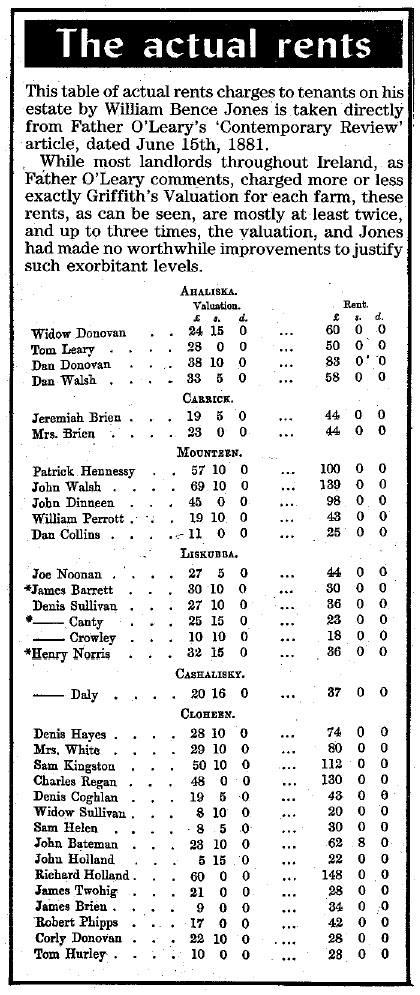
Finding a yardstick for what might constitute fair rents might
have been extremely difficult for anybody anxious to expose rack-renting
landlords, particularly if one considers obvious variations in land quality,
agricultural prices and areas of difficulty such as unimproved holdings, absence
of roads or whatever.
Fortunately for Father O'Leary, there was a yardstick and a yardstick that in
1881 was considerably more valid that it is to-day. namely Griffith's Valuation,
a monumental process of valuing all the land of Ireland carried out in the 1840s
and 1850s by Sir R. Griffith and the Ordnance Survey Department
Griffith's was fair standard
Griffith's Valuation is still the
standard for land valuation and through amended in some counties, is obviously
less than valid now, given the vast changes in agricultural conditions, but in
1881, it was still near enough as accurate as when drawn up, except, as then
stated by Mr. Greene of the Ordnance Survey, where holdings had been
considerably improved.
Where Bence Jones was concerned, however, only a few trifling improvements had
been made, so Father O'Leary was on solid enough ground when comparing his
rents, on the basis of Griffith's Valuation, with rents charged by other Irish
landlords and his first article in the 'Contemporary Review' (June 1881) appends
the rents of 32 of Bence Jones' tenants. The ones omitted were those holding
leases from before Jones had purchased the lands and being unexpired, the new
landlord was not responsible for them, whether, as Father O'Leary says, the
rents were 'low or high'
Father O'Leary cites the fact that when recently the special correspondent of
the London 'Times' visited the large and 'well-managed' estates, particularly
those of the Duke of Devonshire and Earl Fitzwilliam, the rents were 'not much
in excess of Griffith's Valuation.' Griffith's Valuation was expressed as a
certain figure for an entire holding, breaking down to so much an acre, so that
the rent could be expressed as so much an acre or so much for the entire
holding.
If the rents generally in Ireland were around the amount of Griffith's Valuation
per acre, or per holding, Father O'Leary's list was able to show that the rents
charged by Bence Jones were mostly at least twice that level and sometimes up to
three times.
Since the names will still be of interest to people living in the district
to-day. we append the full list in a separate panel and except in the case of
three marked with an asterisk, who are tenants ("on whose deaths the rents will
be considerably raised'), all of the rents are between two and three times
Griffith's Valuation.
The list shows clearly that most of Bence Jones' tenants have rents
significantly higher than Griffith's Valuation. One smallholder in Clogheen, Sam
Helen, whose valuation is £8/5/0, has a rent
of £30, more than three times the valuation,
and another smallholder, James Brien, has a rent almost four times valuation.
Even a larger tenant like Charles Regan is close on three times.
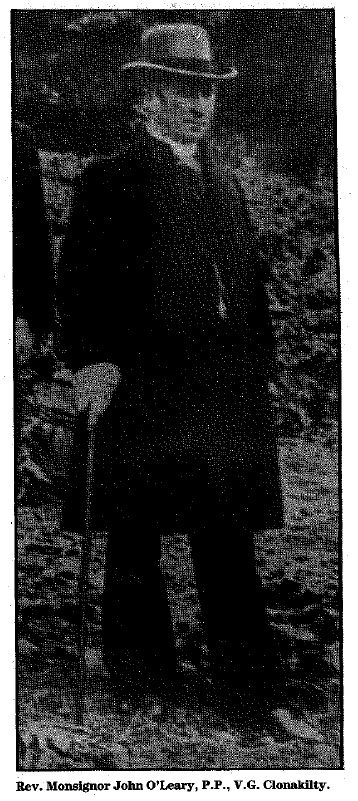
Quotation from Father O'Leary
As to comparisons between Bence
Jones and other neighbouring landlords, a paragraph from Father O'Leary's own
'Contemporary Review' article best illustrates some of the situations and
arguments employed. It reads :-
"(2) Mr. Bence Jones's rents are far higher that the rents on the
neighbouring estates. The proximity of Clogheen to the small town of Clonakilty
has been assigned by Mr. Bence Jones as a reason for charging some of the
tenants three pounds an acre - an English acre, be it always remembered - for
the land which they hold from him there. Of course contiguity to a town adds
considerably to the value of the land. But tenants who hold better land near the
town under other landlords do not pay anything like the rents extracted by Mr.
Bence Jones.
The townland of the Mills is as near to the town as Clogheen. The tenants hold
under Lord Shannon, William Gallwey holds a farm adjoining that of Charles
Regan, and nearer the town. The valuation of Gallwey's farm is
£32, the rent £24. So much for the Mills. The townland of Youghals is also held
under Lord Shannon. Mr. McCarthy holds a farm there for 26s an acre just
opposite that of Mrs. White, on whom Mr. Bence Jones raised the rent to £2 an
acre. Mr. Bence Jones states in his preface adjoining Mrs. White's let last year
at 45s 6d. This is not the case. It let at 35s 6d an acre, and Mr. Bence Jones
omits to say that the tenant who held it previously, though an exceedingly
industrious man, had to throw it up. Lord Bandon had land adjoining Kingston's
farm at Clogheen, the tenants hold at about half Kingston's rent.
Kilbree is the next last to Cashakiskey. The Andy of whom the storey is told in
p. 185 of "The Life's Work" lives there. He bought a farm last year, of which
the rent is 10s an acre. Mr. Bence Jones says it is worth 20s an acre. So that
the tenants in Kilbree hold at about half the rent which they should pay if they
were under tenants to Mr. Bence Jones. It is needless to quote further
instances."
As to evictions, the arguments used by Bence Jones, in these regards are
near to nonsensical but might sound convincing to those without knowledge of the
details and it was on this that the landlord was banking. He had not reckoned on
the likelihood of a man with the astuteness of perseverance of Father O'Leary
taking up the cudgels.
No 'tenant' he wrote, 'was ever turned out because I wished for his land. I just
took up what the tenants could not live on.' This proves, according to him, not
that the rents were too high, but that the tenants were 'incapable, lazy or
drunken.'
'I let them the land' said Jones 'at the highest rent in my opinion it was worth
to them' and further (from 'A Life's Work') he states that 'in bad years, the
utmost exertion and economy were necessary.' Yet, while there was 'terrible
grumbling,' he says of his nine tenants in Carrick in 1865 'every single man was
thriven.'
Father O'Leary's rejoinder on this point is that while he had six tenants in
Carrick in 1865, now (in 1881) 'only three of them are there to-day.' 'This,'
says Father O'Leary, 'is how every man has thriven.'
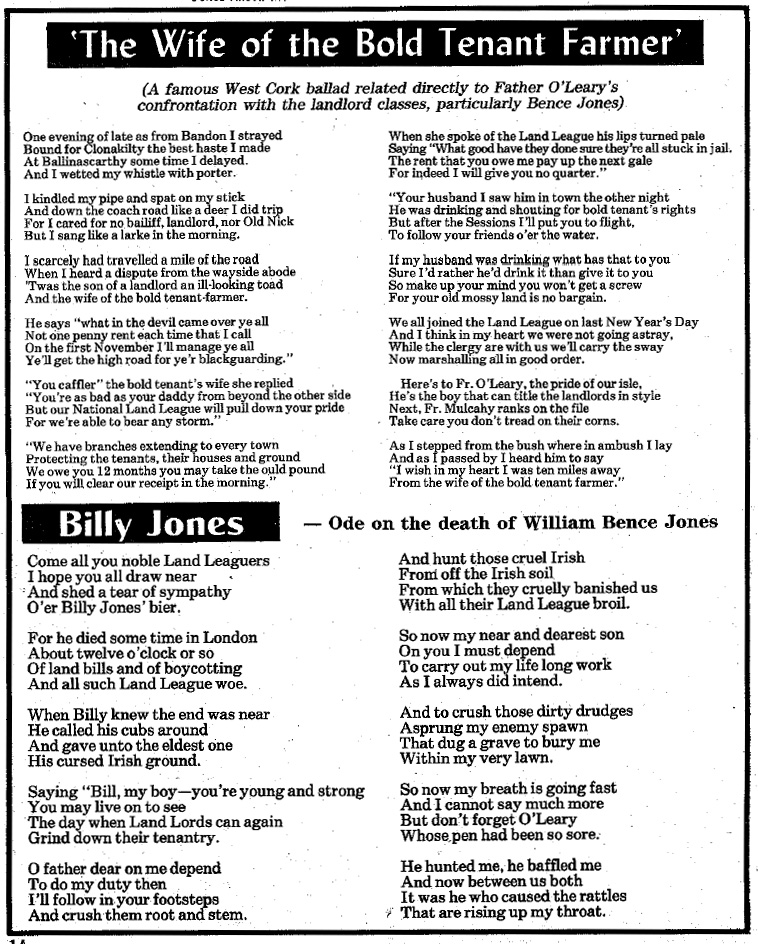
Case histories
Taking some of the 'case histories,' it is illuminating,
briefly, to examine the arguments and counter arguments by Bence Jones, on the
allegations made by Father O'Leary and we will look at six of them in order
given in the 'Contemporary Review' articles.
(1) Widow Dempsey of Clogheen. She, according to Father O'Leary, was a poor
woman who held a small farm at 17s 6d an acre and on the death of her
father-in-law, Bence Jones took away two thirds of the farm and charged almost
the same rent for the remaining one third. Mrs. Dempsey could not pay, so was
evicted with her son-in-law. On this, Bence Jones replied that Mrs. Dempsey was
a 'silly woman, with neither industry nor sense, who married her daughters worse
than badly and got rid of all he money.' He also uses the 'near to the town'
argument for the high rent and that she could have sold milk in town but Father
O'Leary replied again that 'all the Clogheen tenants could not find a market for
milk in the town.' This 'misleading argument' could not justify her rent being
raised 120 per cent, paying four times Griffith's Valuation but Bence Jones
reasons that because she lost he money she was a 'silly woman'.
(2) The Driscoll children of Carrick. Their eviction was according to Father
O'Leary, done under circumstances that 'would melt the hear of the hardest' and
without a doubt, this case is one of the 'blackest of the black' where the
reputation of Bence Jones in concerned. The O'Driscolls, a family 'much
respected in the district' were made orphans when both father and mother died,
and though a rich uncle who came back from Australia (with according to Bence
Jones a very large sum), had himself visited Lisselane House and offered to pay
their rent, Jones according to Father O'Leary 'was inexorable.' He would not
have the land in the hands of orphans (eldest boy was sixteen) and even denied
that the rich uncle offered to pay the rent. Yet, Father O'Leary, in his final
reply, states definitely that "I have it from My Hurley, the rich uncle
who brought £30,000 from Australia, that he made the offer to Mr. Jones in
Lisselane House and was told 'the land could not be left in the hands of
orphans'."
(3) Edward Lucey of Cashaliskey. Most tenants in this townland held leases not
yet run out but Edward Lucey, a 'most respectable man' held from year to year
and was suddenly informed that his rent would be raised from 14s an acre to £1.
This demand was made about 1860 but Lucey, being unable to pay was 'ejected' but
Bence Jones tries to justify it by saying that Lucey's sons successfully farmed
other land a few miles away. Father O'Leary, in replying, points out that Bence
Jones omitted to state that Lucey was told that on his death (nor remote since
was advanced in years), a further 40 per cent increase in rent would be charged
to his sons. Bence Jones is especially condescending here because he claims he
gave him extra time to consider, because 'he had a son a priest.' He was thrown
out, nonetheless.
Taking away of 70 acres
(4) Patrick Hennessy, Mounteen. There were five tenants in
Mounteen, which farm was purchased by Bence Jones about 1860 from a Mr. Hawks,
who was known for 'smart rents' and though landlords there had made no
improvements and done no more than 'fix the rents and collect them.'
Hawkes enjoyed goodwill and affection.
How did Bence Jones try to maintain this goodwill? The largest farm, 130 acres,
was held by Patrick Hennessy, at a rent of £100 but when the lease expired in
1875, Bence Jones confiscated 60 of the acres and made Hennessy pay the old rent
- £100 for the remaining 60. This was a familiar trick.
Patrick Hennessy had himself made large improvements, estimated by him to be
£700 and the custom allowed that in fixing rents, some compensation should be
made, or extra charges if the landlord had paid for the improvements. Bence
Jones did not accept this £700 estimate and insisted that improvements should be
registered according to his own estimate of £100. Is this, asks Father O'Leary
referring to the entire case, confiscation or freedom of contact?
In his reply in 'Contemporary Review,' Bence Jones argues that 'I decided it was
best for us both to leave him the good land and take away the hill' (70 acres)
Father O'Leary in his second reply, comments - 'So Mr. Bence Jones decided that
it was best for both of them to take away the 70 acres.' So he adds,' Germany
decided that it was best for them both France and himself - to take away Alsaace
and Lorraine, and so, too, Russia decided that is was best for them both -
Roumania and herself - to away Bessarabia.'
Bence Jones has also argues that Patrick Hennessy was able to give one daughter
£600 on her marriage and another daughter £150 (husband not so much approved he
hints) but Father O'Leary counters by saying these dowries were given before
1875 when the tenant was independent of the landlord because the lease had not
yet expired until that year.
Bence Jones, then, could not claim credit (as he did) for Hennessy's prosperity
up to 1875 because his lower rent had been fixed by the earlier landlord, Mr.
Hawkes. After 1875, however, with the new Bence Jones 'arrangement' even the
landlord himself, in a letter to the 'Times,' described his condition as
'shaky.'
Hennessy's position however, had been technically strengthened by the 1881 Land
Act and Father O'Leary contends that when his lease next expires in 1882, it
will not be for Bence Jones solely to 'decide what is best for them both.'
Henceforth, new leases could be scrutinised by an impartial tribunal.
(5) Hayes of Carrick. This case was quoted by Father O'Leary to show how, even
with the new Land Acts, powerful landlords could take on the law and get away
with it. Hayes, when evicted by Bence Jones went to court to get compensation
from the County Court Judge but Bence Jones pay it? No, indeed, he claimed he
was 'most unjustly treated by the County Cork judge' and on appealing at the
assizes, 'was forced on a compromise and thus got further relief.'
When Bence Jones replied in 'Contemporary Review' to Father O'Leary's
criticisms, he produced the usual stories about the degenerate Irishry,
mentioning attempted rape by the son and robbery of the fathers potato put, all
being poor excuses for an eviction.
Father O'Leary underlines this in his second reply. 'We are treated,' he says,
'to a long story about robbery and rape and learn how when ages and infirmities
had come on poor Hayes and when his sons had treated him badly, Mr. Bence Jones
came to the rescue - by rescuing the farm - and by forcing on a compromise when
the County Court Judge had given him compensation for disturbance."
(6) Dan Walsh of Ahaliska. This important example Father O'Leary describes as 'a
test case regarding rack rents.' For half a century, he says, and during the
famine years, the Walshes had paid £41 a year for a farm valued by Griffith at
£35 but on the death of Mrs. Walsh in 1880, Bence Jones sought to raise the rent
from 14s 3d to £1 an acre. The tenant complained that this 40 per cent increase
was 'harsh and vexatious' but attempting to justify it, Bence Jones contended
that over fifty years, the Walshes ('a most industrious family') has saved £820.
Father O'Leary retorts that about half of this was not attributable to farming
(dowries and other sources being cited) and he also contends that of the Walsh's
supposed 58 acres, five acres had 'been lost by a road made through the farm,'
this being the 'hardest, unkindest cut' because apart from paying for the road
in rent, same as if it were land, the tenant had to pay for making the road and
its upkeep.
So what does Bence Jones do? On finding that the Walshes are saving about £16 a
year, he 'puts on exactly an increase of rent equal to what he calculates the
yearly savings of that family had been for the past half century.'
Imagine, exclaims Father O'Leary, 'an English landlord computing the annual
profits of his tenants and adding that to the rent and during an agricultural
depression unequalled since 1848, when landlord after landlord is reducing
rents.'
'Surely,' concludes Father O'Leary, 'Bence Jones is a considerate landlord.'
In his 'Contemporary Review' reply, Bence Jones admits defeat, more or less and
is reduced to arguing about the space taken by the road, describing it as a
'great gain' and further, 'if they made good butter, instead of bad, the
difference would be double, the increased rent sought.'
To this, Father O'Leary's rejoinder is most delicate - 'only let the frog puff
himself out and he will be as big as the bullock.'
Four other similar case histories are given but these will suffice to paint the
picture. Additionally, there is a lengthy argument about the so-called 'balance
sheets' cited by Bence Jones in his "Life's Work" and Father O'Leary uses them
to turn the landlords word against himself - i.e. his sometime contention that
Irish farming was unprofitable and yet, he himself did very well out of it.
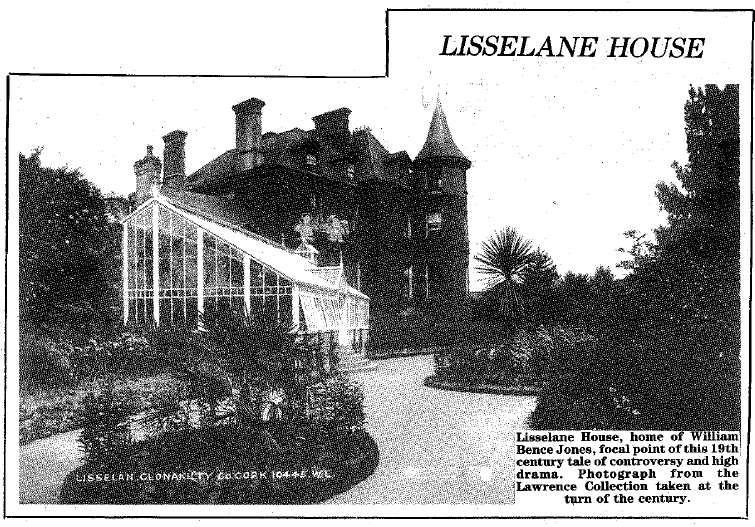
The boycotting of Bence Jones is another saga. Having head the
'Life's Work,' the English people, said Father O'Leary, were amazed to find that
Jones has been boycotted, that his labourers left his employment, that he could
not get provisions for his household in his own village of Ballinascarthy, that
his corn could not be sold in 'Orange Bandon,' that more than one steamship
company refused to convey his cattle to England and that even when they got to
Liverpool it was not east to get purchasers for them.
'What Homer have been to Achilles,' concludes Father O'Leary, the classical
scholar, 'Bence Jones has been to himself.' He seeks to 'tie up within his own
discomfiture the fair name of an ancient nation' and according to him the 'Irish
trouble is nothing else than the outcome of the low moral and social state of
the people.'
Why was Bence Jones boycotted asks Father O'Leary. 'Because,' says the
correspondent of the 'New York Herald,' ' he was the worst of Irish landlords'
but according to Bence Jones himself, it was 'because he was a good landlord.'
Amazing self-deception, assuredly, but it deceived nobody.
Bence Jones also accused Father O'Leary and the parish priest Father Mulcahy of
'drawing away his labourers' in the boycott and here he is challenged to provide
proof and fails miserably, except that some men were seen going into the P.P.s
vestry. 'Excellent logic,' retorts Father O'Leary, that a 'priest could speak to
his parishioners in his own parish.' Their treatment would take another chapter
and in Bence Jones's own book, he admits that 'in summer, they must appear in
the field, with breakfast taken, at six o'clock, with only one stop, at mid-day.
To find a closing paragraph to this terrible tale of 19th century oppression of
a mostly poor and starving people is, so myriad are the complexities of the
saga, difficult, but Father O'Leary himself provides a touching and beautifully
written, as it might be called, epitaph.
'The end of Bence Jones' life's work,' was not written when his book was
completed.' 'Another chapter remained to be added, the chapter which contained
the denouement, as unexpected as tragic, which told of the way in which he had
been repaid by the Irish people for having done his duty to them for forty
years.'
Of tragedy
"And in truth, the tale now tolerably familiar to the world, is
terrible withal. To be placed in the circumstances in which he describes himself
to have lived in Lisselane during the snows of the most inclement winter which
our generation has witnessed; circumstances, which, as he tells us, and as we
can well believe, would have tested the patience of a Job, and which is no less
that the guilty conscience of Macbeth would have murdered sleep - 'sleep that
knits up the ravelled sleeve of care' - to be placed in such a situation would
undoubtedly have been a dire retribution for the worst Pasha that ever oppressed
a province, or the most rapacious landlord that ever extorted the hard-earned
substance of the poor. And yet this victim tells us that he is a benefactor of
the people."
Bence Jones, it is clear, had, in the last two years of his life, been boycotted
and blackballed by everybody in Ireland, even by his coreligionists and while
this ancient storey, a tale of tragedy and high drama, is no longer 'tolerably
familiar to the world,' the denouement that Father O'Leary mentions is some what
unclear.
The effective imprisonment of Bence Jones in the Lisselane Castle of his own
greed, rapacity and cruelty is the likely meaning but then, like Dr. Webster of
Cork referred to elsewhere, Bence Jones also 'fled the country' for London on at
least two occasions before his death in 1882.
According to the 'Skibbereen Eagle,' he did return, probably briefly in February
1882, accompanied by his son, but then must have left again because the general
belief is that on the occasion of another return, later in that year, his death
took place aboard ship.
If the famous Captain Boycott incidents in County Mayo had not received
notoriety prior to the 1881 saga of Bence Jones and Father O'Leary, the strong
belief is that the term 'bencing' would have passed into common usage rather
than 'boycotting' and that is a true measure of William Bence Jones of Lisselane
near Ballinascarthy in West Cork.
Editor